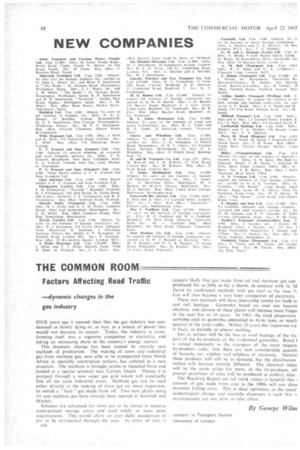THE COMMON ROOM
Page 90

If you've noticed an error in this article please click here to report it so we can fix it.
Factors Affecting Road Traffic
—dynamic changes in the gas industry
FIVE years ago it seemed clear that the gas industry was condemned asslowly dying or, at best, as a source of power that would not increase. its output. Today, the industry is transforming itself into a vigorous competitor to electricity and taking an increasing share in the country's energy market.
This dramatic change has been caused by entirely new methods of production. The making of town. and industrial gas from methane gas, now able to be transported from North Africa in specially constructed tankers, has ushered in a new situation. The methane is brought across in liquefied form and landed at a special terminal near Canvey Island. Thence it is pumped through a new super gas grid which will eventually link all the main industrial areas. Methane gas can be used either directly in the making of town gas or. more important, to enrich at " lean-" gas made from oil. Two new plants using oil and methane gas have already been opened at Southall and Hitchin.
Schemes are advanced for town gas to he stored in massive underground storage areas and used solely to meet peak requirements. This would allow an even daily production of grts to he maintained through the year. In terms of cost, it s56 appears likely that gas made from oil and methane gas can produced for as little as 6d. a therm, in contrast with Is. 3d therm by traditional methods with gas coal as the base ft Gas will thus become a very keen competitor of electricity.
These new methods will have depressing results for both re and rail haulage. Gasworks based on coal are becomi obsolete, and closure of these plants will become more frequi in the next five to 10 years. In 1963, the road proportion carrying coal to gasworks amounted to 4+ m. tons, or neath quarter of the total traffic. Within 20 years this important tra is likely to dwindle to almost nothing.
Just as serious will be the loss to road haulage of the tra port of the by-products ol' the traditional gasworks. Road 1 a virtual monopoly in the transport of the most import; by-product—coke -but there are also considerable quantit of benzoic, tar. sulphur and sulphate of ammonia. Naturai these products will still he in demand, but the distribution outlets will become entirely different. The chemical indus will be the main outlet for many of the by-products, wlgreater quantities of coke will he produced at colliery sites.
The Beeching Report on rail trunk routes is hopeful that I amount of gas made from coal in the 1980s will not show dramatic falling away. This is sheer optimism, as the speed technological change and scientific discovery is such that n developments are not slow to take effect.
By George Wilm
Lecturer in Transport Studies University of London




































































































































